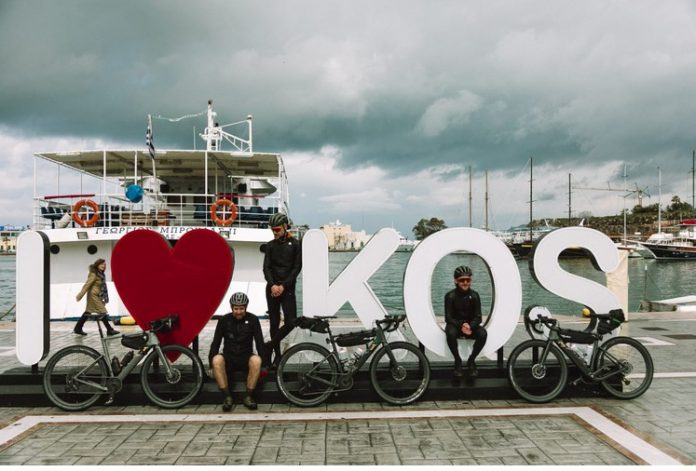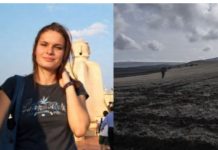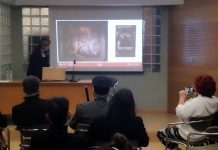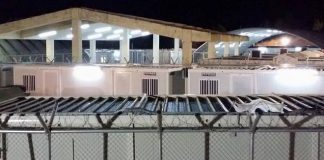Αφιέρωμα της Ιταλικής 3Τ πού παρουσίασε πριν από ένα μήνα το νέο τής μοντέλο στην Κω.
Από όλη την Ευρώπη επέλεξε το νησί της Κω.
XPDTN3 Greece: a Ultra-rainy loop of the island of Kos

«In Kos, it rains only 8 days per year!», and apparently all concentrated at the beginning of March when this expedition took place. Three cyclists had to face an unexpected, yet fascinating situation, and ride three days around this beautiful island of the Dodecanese archipelago testing the all new Exploro Ultra.
Kos island, the 3rd largest in the Dodecanese, is a modern tourist destination with high quality hotels, numerous good eating and drinking establishments and many options for fun and activities. In summer the roads around the port are almost impassable. Pedestrians, cyclists, motorbikes and cars move in and out in all directions. The music from the bars and taverns mixes with the noise of the street, with the voices of sunburned and drunken tourists as well as with the horns of incoming and outgoing ships. The tourist season in Kos lasts from April to October, peaking in August.

The island has an area of 295 sq. km , 112 km of coastline and over 33000 permanent inhabitants, mostly engaged in tourism. The history of Kos goes far back in time. A walk in the city is enough to find this out. Hippocrates, the famous father of medicine, was born in Kos. Hippocrates is considered the founder of scientific medicine. He passed healing from the hands of the magicians to the hands of the doctors. He founded a medical school in the Asclepieion of Kos, traveled a lot and wrote many books that survive even to this day. His approach to medicine was what we now call holistic, dealing not only with the symptoms but mainly with the causes. His mark in the history of medicine is indelible, graduate doctors all over the world begin their careers giving the oath of Hippocrates which refers mainly to the ethical practice of medicine.

The fact that medicine was developed there which included philosophical implications means that society was advanced. The city of Kos is built on the ruins of great civilizations. Walking around the narrow streets of the city, you find yourself in front of stone theatres that were built from the 3rd century BC, you find yourself in front of temples and the ancient market that gathered goods from east and west, but the most important archeological monument is located 3.5 km outside the city and is the Asclepieion. In addition to being a place of teaching, it was a place of worship, sports and other social events. In 260 BC in the Asclepieion of Kos also recognized the right to immunity, i.e. the right of every persecuted person to find refuge there. All this demonstrates the cultural level but also the power that Kos had.

The Middle Ages erased many elements of ancient prosperity in Kos. It was then looted by Saracen pirates, conquered by the Genoese, the Venetians and in 1315 by the Knights of the Order of St. John as were the remaining Dodecanese islands. In 1522 Kos passed to the administration of the Ottoman Empire and in 1912 it became fell into the possession of Italy. It was about this time that the wheels of the first bicycle on the island were pressed. Together with the army, the Italians brought bicycles and soon the first shops opened for trading and started repairing them. The period of Italian rule ended in 1943 when Mussolini was forced to sign a truce. From that moment on, German forces attacked the Italian army mercilessly. The German occupation lasted only 2 years but managed to destroy what centuries of wars and battles had not destroyed. They also drove away the Jews who lived there while executing people and bombing even without a reason. In 1945 the British arrived as liberators, but their practices did not differ that much from those of previous conquerors, which brought major dissatisfaction to the islanders. The desire for democratic governance and integration within Greece resulted in the union on October 28, 1947.

The conquerors came and went and all left evidence in Kos that testifies to their passing. During the Italian occupation many excavations were made to highlight the antiquities, a road network was created and some of the buildings they built to house administrative services and settlers still stand and tell stories from the past. The Italians, as mentioned previously, also brought the bicycle to the island. The flat terrain of the city and many other factors favored it to become a habit for the residents and for visitors. Since the 1990s, plans and studies have begun to create bike lanes to reduce motor traffic. Results came soon, the first bike lane was made in the port, then to the nearby beaches and in the city while at the same time several roads were closed to cars and became exclusively for pedestrians and bicycles.
My first visit to Kos island was in 2017 as a guest in the International Trail Building Week . Then, together with a team of trail builders from Italy, Germany, Switzerland together with the valuable assistance of local riders we built the first trails for MTB Enduro in Kos, Leros, Lipsi, Nisyros and Patmos islands that lead to many more. Since then I have visited many times as a guide or to visit friends and ride a bike. Every time I visit I see the network growing with the cycling community and that fills me with optimism.

When I was offered to participate in this mission I accepted with great pleasure. A few days later, I got in contact with some of the other members. Andrea and Luca were in Italy and George in Kos. We were all looking forward to the day of the trip. I started packing my bags a week before and prepared a swimsuit. I had a raincoat in hand along with other minor things. However as the days of departure approached I was looking at the weather forecast and changing my priorities in equipment. I expected that the Aegean would welcome us colored by the flowers of spring, with clear blue waters, the unique Aegean sunlight and other stereotypes, but it’s good not to make plans, especially when it comes to the weather…

Day 1
Arriving at Kos airport we went straight to Sernikos Bikes store where our bikes had arrived and were almost ready by the technicians. We made the last adjustments and set off in a hurry because the first day of our trip might have been the only day we could ride in the sun.
We set off at the port and followed the coastal bike lane until we turned right towards the mountain. Luca and Andrea and I had only just met in person, but from the start it was easy to ride together. We kept up a strong pace and we were all excited. So excited that we made a mistake on the way – instead of going from the wetland to the beach we went straight to the mountain with the result that the escort car lost us and we had to stop. While we were waiting, a local farmer approached us and we started talking.

When I told him that Andrea and Luca are from Italy he started telling us a story from the end of the Italian rule. He was very young then but he remembers two Italian soldiers who did not surrender and took refuge in a stone hut just above where we were. His father gave them water, some food from their pot and milk from the goats. At some point the Italian soldiers disappeared and he never found out if either they were captured by the Germans and executed or somehow had returned to their homeland to their families and how they may remember in their old age a little boy who brought them food in a knapsack.
This story brought to my mind the institution of asylum, maybe “Barba” Antonis has no idea about ancient history but he keeps it alive, maybe the Italian soldiers were invaders up to then but at that time they needed protection. I also thought that in another era Andrea and Luca and I might have been in opposing camps and fighting without knowing why. At the end of the story, the escort car arrived. George and the crew that covered our mission were a little annoyed with our mistake but with the story of “Barba” Antonis we were absorbed. When they approached us and saw us sitting on the terrace they calmed down and they realized that this was the purpose of our trip.

We continued and the higher we went, the stronger the wind was until we reached the col and Lake Sympetrou. At this point begins one of the most beautiful trails I have ever ridden.
Most of it is right at the edge of the ridge, left and right show the Turkish coast, Nisyros, Kalymnos, Pserimos and the endless blue of the Aegean. The exclamations of our joy were taken by the wind as we descended.

We saw the first houses of Zia just before nightfall, my smart watch read 30 km and 750 m elevation. It was not a long distance but everything we experienced and saw was more than enough to make us go to bed with a sweet tiredness.
Day 2
From the previous day black clouds were coming from the east. The forecast said that the rain would start in the afternoon so we said to start early to be able to ride “dry” for most of the route. We started in the direction of one of the most important castles of the Dodecanese.

The medieval settlement of Palio Pyli is located at an altitude of 300 m with natural fortifications. It was built before the 11th century AD and was inhabited until 1810 when it was abandoned after an epidemic. Up to a certain point it is reachable by a dirt road but it was closed due to a landslide, we pushed the bikes for a while and we reached the point where the main cobblestone road that passes through the ruined settlement starts.
We wanted to stay there a little longer but the clouds that were thickening above us did not leave us much time. From the old settlement to reach the dirt road again the path was rugged and the ride was not very comfortable with gravel bikes. However, often it does not matter so much if you ride on an enduro, cross-country or gravel bike, it matters where you are. I had been to Palio Pyli before in the summer when the colours on the rocks were a bit faded and everything around was dry. Now that everything was moistened by the humidity and bright green, the place looked completely different.
We passed outside Kardamena and reached the beginning of another cobbled path that leads to the castle of Antimacheia . The “Italian path” as it has become known is another remnant of the passage of the Italians.
Arriving at the castle the first raindrops fell, it was approaching noon. Our next stop was Kefalos. We had planned to stop there for lunch and sit on the beach.

Before we started the trip I had imagined that when we were there it would be sunny but when we entered the area with the dunes it was as if a giant shower opened above us, the rain and the wind were coming from all directions. We stopped for a while to wait for the rain to pass but it was in vain. When we were cold enough we decided to set off, but to change the plan and not to go to Kefalos.
We passed the airport and just outside Antimachia I stayed behind Andrea and Luca , it was so cold that it was impossible for me to follow their pace and the escort car was stuck behind me. At one point it came next to me and George opened the window to ask me if I was ok. A sweet heat came out of the window and made me want to be inside it even though I had only covered 55 of 70 km .
The remaining 15 km of the route was spent in the passenger seat with the heating on full , misty windows and the soothing music from the radio. Once or twice we went next to Luca and Andrea and they seemed to be enjoying themselves incredibly.

Day 3
Our equipment had not dried by the time we left the next day. Anyway, when we left the hotel to start the third day, it was raining again, so even if it had dried, everything would get wet again after a few minutes. We left for the Asclepieion and the Hippocratic Institution but our visit there made no sense. It was raining so hard that the only wise choice was to keep moving. The dirt roads we followed had turned into rivers, elsewhere large waterways had been created and trees had fallen. Kos looked more like the Pindus mountain range!
The first part of the route, the climb, ended quickly and we found ourselves on the mountain above the city. Down or on the horizon we saw nothing other than the fog and entered another path, the Flow Turtle is one of those that have been made in recent years and it really is one of the most beautiful flow trails in Greece, every metre has been carefully constructed and every turn has the perfect inclination to keep the bike on track without much braking. After two days of riding with the Exploro Ultra I felt comfortable trusting it on an enduro trail, even though the conditions were adverse. Very soon I found myself at the end of the trail waiting for the other two with a wide muddy smile to proceed to a different side of the mountain that was unknown to me.

Above Therma the fog had thickened and we had minimal visibility, water was flowing from everywhere and if we did not have the track in GPS we would definitely have been confused, we could not distinguish the road from a stream. The bad weather started to subside when we reached the beach. We still had about 20 kilometers to complete the tour. As soon as our wheels hit the asphalt, the clouds began to dissipate slowly and a cowardly sun came out. Before reaching the city we stopped at the wetland that we accidentally skipped on the first day.. The breeze had dried our clothes a bit when we arrived at the port and the inconvenience from the rain seemed distant.

We started inspecting the bikes. All these days we did not have time to do it. I tried to understand what was it that made me enjoy comfortable and safe riding. I’m not an expert on gravel bikes, I’ve ridden a few but it was easy to decode the geometry with the short asymmetric chainstay , the angle on the headtube that gave it stability and passed over anything. Its peripherals also played an important role. The electronic shifting allowed me to lower quietly even on the hardest uphill cobblestones and Crank Brothers hydraulic seatpost was something I had not imagined could be useful on a gravel bike but when I positioned my body back to descend in steep places I appreciated it. But the biggest innovation of 3 T Explore Ultra is that it accepts tyres of up to 2.25 inches.

Before we went up to our rooms to get ready for the departure, we left the bikes in the bike shop to pack them and send them back to Italy. After Kos I learnt they would be travelling to exhibitions in Europe. When I rested my bike on the stand I passed my hand over the horizontal tube as if to caress it, as if to say goodbye to a friend after having had a good time together and now everyone is going their own way.

When planning this trip we definitely had other images in mind, especially our Italian friends. We could say that the weather did not help us to realize them at all. However, when we said goodbye we were all happy, full of images and sure that we would return to Kos in better weather and we would say “do you remember that bad weather in Kos? .. didn’t we have a great time!! ”
* in the writing of this article, no animal experiments were made, no rider was injured, no pneumonia or other illnesses related to cold and rain were reported.

During this XPDTN3 , Andrea and Luca made a video backstage of what you’ve just seen and read. They have posted it on their YouTube Channel, called “Gravellata”. The video is in Italian, but we hope that the YouTube automatic subtitles could help you with that…
If you got curious while scrolling between lines and photos about the Kos XPDTN3 and would like to try the experience yourself (hopefully with a bit of better luck regarding the weather), you can find the Komoot routes down below. We strongly suggest you start from the Sernikos bikes shop, so to be sure to find experienced and skilled personnel in case you had to face one of the many inevitable pre-departure unforeseen events, or even just buy something you forgot home!





























ειρθαν οι Ιταλοί να επιβεβαιωσουν αυτο που οι κύριοι καματερος,χονδρος,δυναμη σαλια-λλαγης,και κάποιοι αλοι του κυριτση,που γράφουν με διαφορετικά ονόματα.ΝΙΚΗΤΑΡΑ δικαιωνεσαι για την εργατηκοτητα σου,και για όλα τα καλά που προσφέρεις στο αγαπημένο μας νησί.
Το «I love Kos»όπως και να το κάνουμε δεν μπορεί να είναι η μπροσούρα της ιστορικής και Ιπποκρατικής Κω, τοποθετημένη μάλιστα μπροστά στο Δημαρχείο. Άλλο είναι το έμβλημα του νησιού, που βλέπουμε να παραμένει ανάγλυφο στο κτίριο αυτό. Το «I love Kos» μόνο σε μια κοσμική παραλία θα ταίριαζε να τοποθετηθεί. Τόσο πολύ πια ξέπεσαν οι αξίες και τα σύμβολα αυτού του νησιού, θυσιασμένα όλα στο βωμό του κέρδους μιας άναρχης τουριστικής καταιγίδας;;
Ποιο κοσμοπολίτικο ντεκόρ με τις θαλαμηγούς υπάρχει? Από την μεριά της θάλασσας είναι καθαρά η τουριστική χλιδή. Στα άλλα που είναι τα αρχαία είναι διαφορετικά. Το i love kos είναι στην ΣΩΣΤΗ ΘΕΣΗ.
ΔΗΛΑΔΗ ΤΩΡΑ ΔΙΚΑΙΩΝΕΤΕ Ο ΔΗΜΑΡΧΟΣ,ΟΤΑΝ ΟΙ ΚΑΤΗΓΟΡΙΕΣ ΕΠΕΦΤΑΝ ΒΡΟΧΗ.ΕΓΩ ΤΩΡΑ ΤΙ ΠΡΕΠΕΙ ΝΑ ΥΠΟΣΤΗΡΙΞΩ;ΤΟΝ ΚΥΡΙΤΣΗ ΠΟΥ ΤΟ ΧΛΕΥΑΖΕ,Η,ΤΟΝ ΔΗΜΑΡΧΟ ΠΟΥ ΤΟΝ ΚΑΤΗΓΟΡΟΥΣΑΝ.ΜΑ ΔΕΝ ΕΙΜΑΙ Ο ΜΟΝΟΣ ΚΥΡΙΤΣΙΚΟΣ ΠΟΥ ΒΛΕΠΕΙ ΤΗΝ ΑΛΗΘΕΙΑ,ΕΧΕΙ ΚΑΙ ΑΛΟΥΣ.ΣΥΓΝΩΜΗ ΚΥΡΙΤΣΗ ΑΛΑ ΟΙ ΑΛΗΘΙΕΣ ΜΑΣ ΠΟΝΑΝΕ.
Περίεργο.Στην Ιταλία μιλάνε Αγγλικά;Θαύμα.Όσο για κάποιους που χαιροντε που υπάρχει πρώτη φωτό αυτό το κιτς που υπάρχει παντού σε όλο τον κόσμο το βρίσκεις αυτό το love τι να πω.Δεν έχουμε σαν νησί τίποτα άλλο να προβάλουμε και με αυτό είμαστε γνωστοί .Άξιοι.
miranta
βαλε την κρεμα σου να ξεζαρωσεις, και παρατα την πολιτικη γιαυτους που ξερουν και μπορουν!!